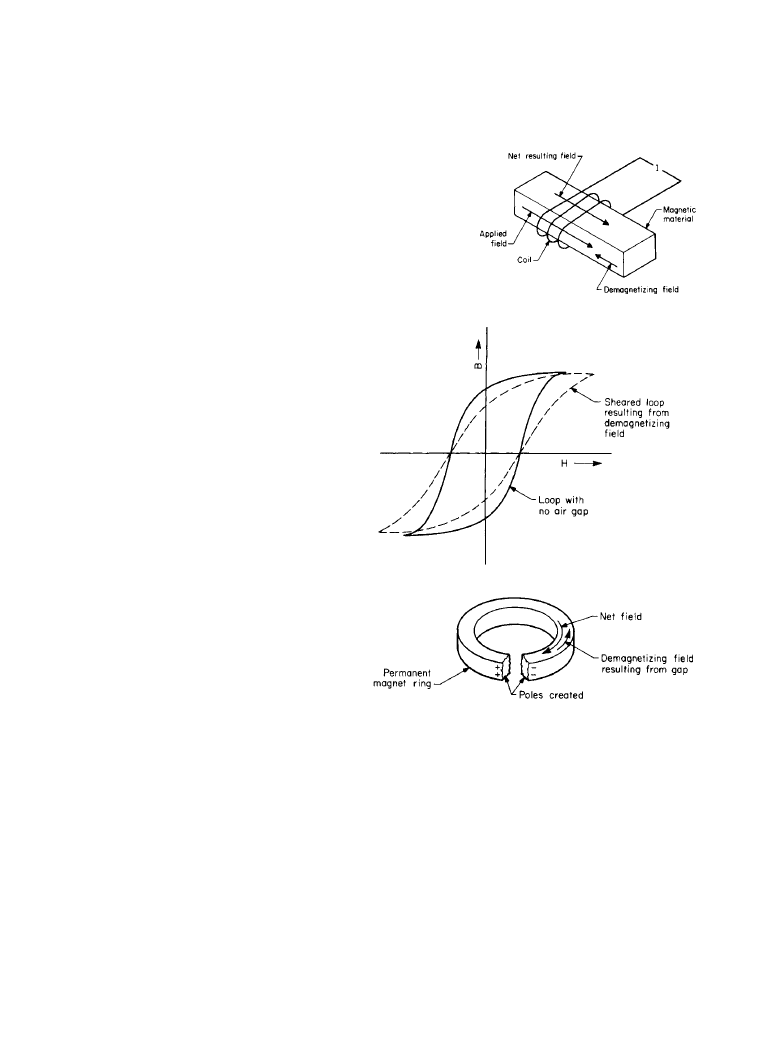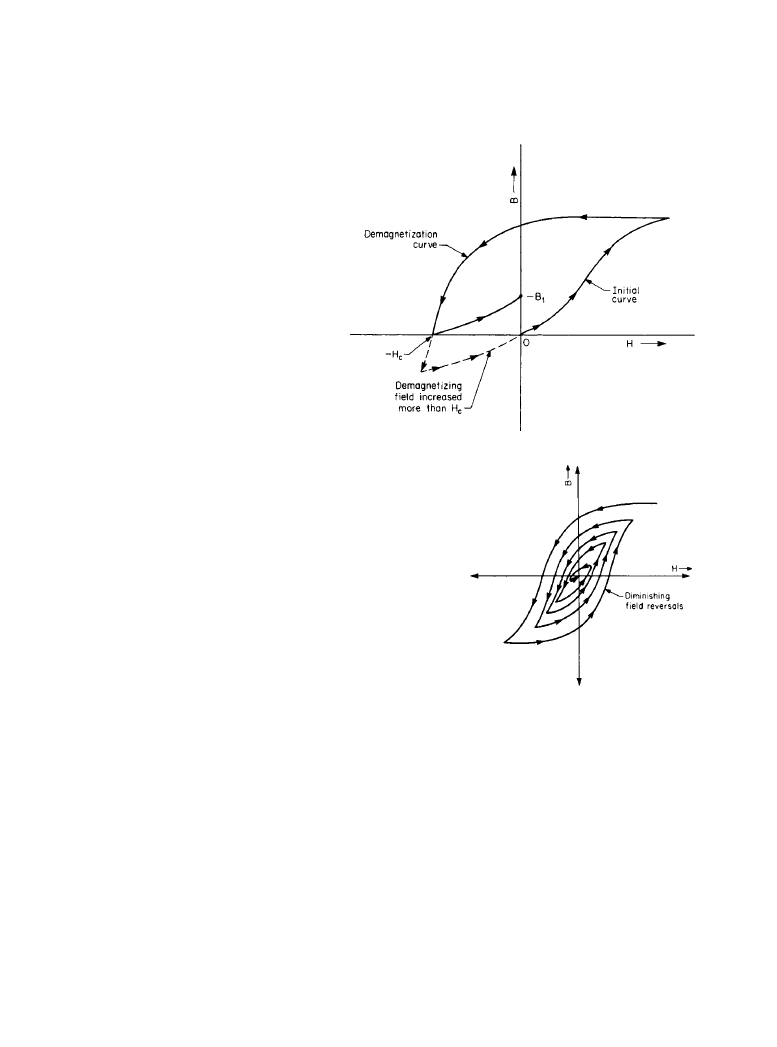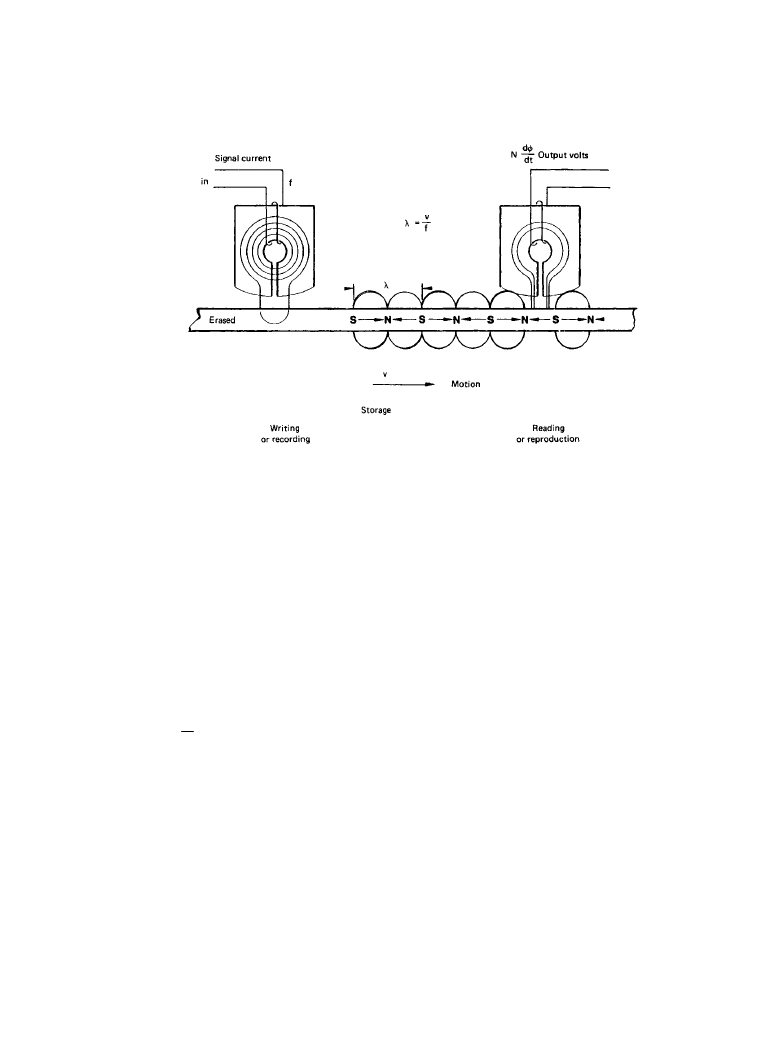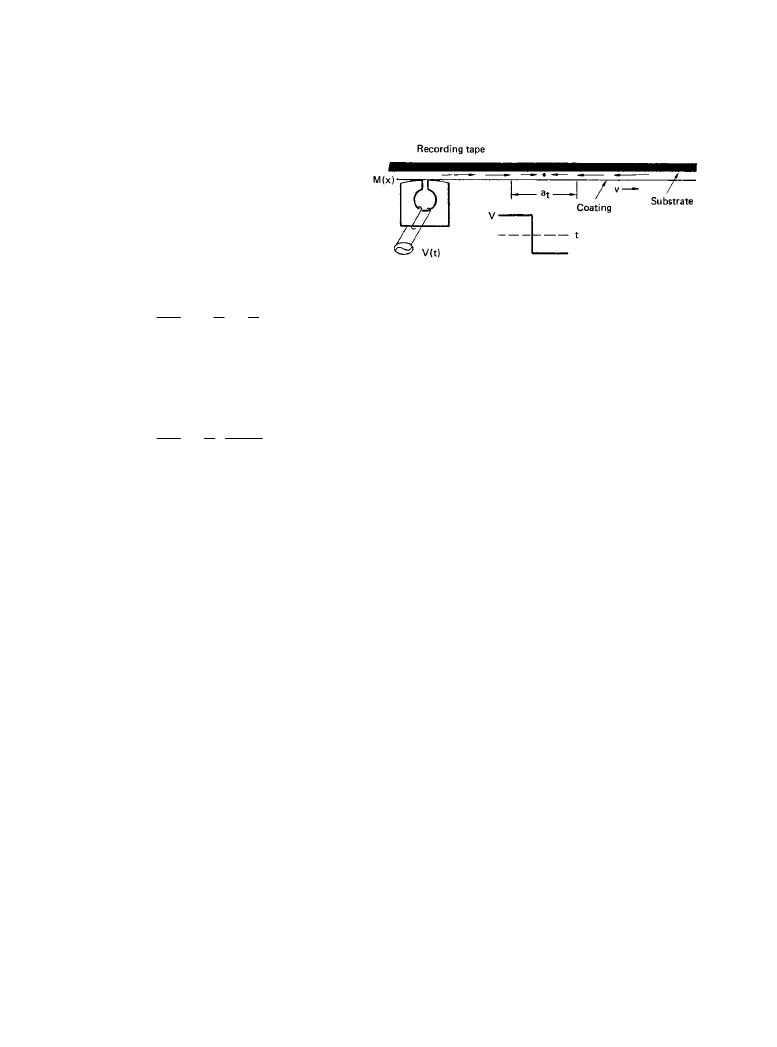ВУЗ: Казахская Национальная Академия Искусств им. Т. Жургенова
Категория: Книга
Дисциплина: Не указана
Добавлен: 03.02.2019
Просмотров: 21715
Скачиваний: 19

Properties of Magnetic Materials 9-37
nique is used to bulk erase magnetic tape and other recording media, by exposing it to a strong ac
field and then slowly removing the magnetic media from the field.
9.2.3
References
1.
Chikazumi, Soshin: Physics of Magnetism, Wiley, New York, N.Y., 1964.
2.
Smit, J., and H. P. J. Wijn: Ferrite, Wiley, New York, N.Y., 1959.
3.
Bozorth, Richard M.: Ferromagnetism, Van Nostrand, Princeton, N.J., 1961.
4.
Pear, C. B.: Magnetic Recording in Science and Industry, Reinhold, New York, N.Y., 1967.
Figure 9.2.9
Sheared hysteresis
loop.
Figure 9.2.8
Demagnetization field.
Downloaded from Digital Engineering Library @ McGraw-Hill (www.digitalengineeringlibrary.com)
Copyright © 2004 The McGraw-Hill Companies. All rights reserved.
Any use is subject to the Terms of Use as given at the website.
Properties of Magnetic Materials

9-38 Audio Recording Systems
5.
Jorgensen, Finn: The Complete Handbook of Magnetic Recording, Tab Books, Blue Ridge
Summit, Pa., 1980.
6.
Kraus, John D.: Electromagnetics, McGraw-Hill, New York, N.Y., 1953.
Figure 9.2.10
Demagnetization
curve.
Figure 9.2.11
Demagnetization by reversals.
Downloaded from Digital Engineering Library @ McGraw-Hill (www.digitalengineeringlibrary.com)
Copyright © 2004 The McGraw-Hill Companies. All rights reserved.
Any use is subject to the Terms of Use as given at the website.
Properties of Magnetic Materials

9-39
Chapter
9.3
Recording Fundamentals
Charles P. Ginsburg, Beverley R. Gooch, H. Neal Bertram
9.3.1
Introduction
The basic elements of a magnetic tape recorder are illustrated in Figure 9.3.1. A magnetic tape is
moved in the direction indicated by a tape-drive device or transport. The magnetic coating of the
tape contacts the magnetic heads in a prescribed sequence, starting with the erase head and end-
ing with the reproduce head.
The erase head demagnetizes the tape coating by exposing the magnetic particles to a high-
frequency field that is several times greater in strength than the coercivity of the particles. As the
tape is drawn past the erase head, the erasing field gradually decays, leaving the magnetic coat-
ing in a demagnetized state.
The tape then moves into contact with the record head, which consists of a ring-shaped core
made of a relatively high-permeability material, and having a nonmagnetic gap. A magnetic field
fringes from the gap, varying in accordance with the magnitude of the current signal flowing in
the head coil. With low-level signals the field is small, and some magnetic particles in the tape
coating will be forced into alignment with the field. As the signal field is increased, a larger
number of particles will become oriented in the direction of the recording field. As the tape is
moved past the record gap, the magnetic coating acquires a net surface magnetization having
both magnitude and direction. This magnetization is a function of the recording field at the
instant the tape leaves the recording zone, a small region in the vicinity of the trailing edge of the
gap.
The magnetization of the fundamental recording system just described is not necessarily lin-
ear with respect to the head current. Linear magnetization can be achieved by adding a high-fre-
quency ac bias current to the signal current. Audio recorders use such a scheme to linearize the
tape and reduce the distortion. In video recorders, the signal information in the form of a fre-
quency-modulated carrier is recorded directly, without ac bias.
9.3.2
Fundamental Principles
When the tape approaches the nonmagnetic gap of the reproduce head, the flux d
Φ/dt from the
magnetized particles is forced to travel through the high-permeability core to link the signal
windings and produce an output voltage. The output voltage is proportional to d
Φ/dt, the rate of
Downloaded from Digital Engineering Library @ McGraw-Hill (www.digitalengineeringlibrary.com)
Copyright © 2004 The McGraw-Hill Companies. All rights reserved.
Any use is subject to the Terms of Use as given at the website.
Source: Standard Handbook of Audio and Radio Engineering

9-40 Audio Recording Systems
change of the inducted flux, and therefore will rise at the rate of 6 dB per octave until a wave-
length is reached where the gap and spacing losses begin to reduce the head output.
9.3.2a
Recording Signal Parameters
The physical distance that one cycle of the recorded signal occupies along the tape is called the
wavelength, which is directly proportional to the relative velocity between the head and the tape,
and inversely proportional to the frequency of ’ the recorded signal. It may be expressed as:
(9.3.1)
Where:
λ = wavelength, in
v = velocity, in/s
f = frequency, Hz
The linear packing density is the number of flux reversals per unit length along the recording
medium. Because there are two flux reversals, or bits, per cycle, the linear packing density may
be expressed as:
v
f
λ
=
Figure 9.3.1
Fundamental recording and reproduction process.
Downloaded from Digital Engineering Library @ McGraw-Hill (www.digitalengineeringlibrary.com)
Copyright © 2004 The McGraw-Hill Companies. All rights reserved.
Any use is subject to the Terms of Use as given at the website.
Recording Fundamentals

Recording Fundamentals 9-41
(9.3.2)
The area packing density is the number of bits per unit area and is, therefore, equal to the
number of recorded tracks per inch times the linear packing density, or:
(9.3.3)
When the magnetization is oriented in the direction of relative motion between the head and
tape, the process is referred to as longitudinal recording. If the magnetization is aligned perpen-
dicular to the surface of the tape, it is called vertical or perpendicular recording.
Transverse recording exists when the magnetization is oriented at right angles to the direction
of relative head-to-tape motion. From these definitions, longitudinal magnetization patterns are
produced by both rotary- and stationary-head recorders.
9.3.2b
The Recording Process
The recording process consists of applying a temporally changing signal voltage to a record head
as the tape is drawn by the head. The magnetic field that results from the energized head records
a magnetization pattern that spatially approximates the voltage waveform. In saturation or direct
recording, the signal consists of polarity changes with modulated transition times or zero cross-
ings. Strict linear replication of this signal is not required because the information to be recov-
ered depends only on a knowledge of when the polarity transitions occur. Examples are digital
recording, where the transitions are synchronized with a bit time interval and occur at bit posi-
tions depending upon the coded pattern, and FM video recording, where a modulated sine wave
is applied so that the transitions occur not regularly but according to the signal information con-
tained in the modulation.
The essential process in direct recording, therefore, is the writing of a transition or polarity
change of magnetization. In Figure 9.3.2, the resulting magnetization from a step change in head
voltage is shown. In saturation recording, the spatial variation of magnetization will not be a per-
fect replica of the time variation of signal voltage. Even if the head field change is perfectly
abrupt, the magnetization will gradually change from one polarity to another. In Figure 9.3.2,
this is indicated by a gradual change in vector lengths; the notation a
t
denotes an estimate of the
distance along tape over which the magnetization reverses. The nonzero distance between polar-
bits
2
2
2
in
λ
λ
=
=
2
bits
2 tracks
in
in
λ
=
Figure 9.3.2
Resultant magneti-
zation from a step change in
head voltage.
Downloaded from Digital Engineering Library @ McGraw-Hill (www.digitalengineeringlibrary.com)
Copyright © 2004 The McGraw-Hill Companies. All rights reserved.
Any use is subject to the Terms of Use as given at the website.
Recording Fundamentals